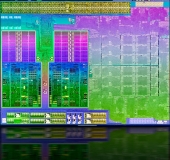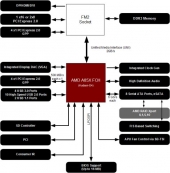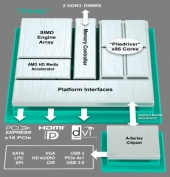 |
Trinity
Trinitys’ design is an overall upgrade from Llano: Better cores, better GPU. We see that AMD has used the ‘Piledriver’ Cores for Trinity where Llano used the Bulldozer architecture (FX series) Chips. This should translate into better CPU performance over Llano that were based off of the Phenom cores. But how much better is the question? And will this performance difference be seen in gaming and applications? More to the point, will the difference be compelling enough for consumers to move to the new FM2 socket and Trinity as a solution. To that point we see that AMD has upgraded from the 6xxx series GPUs found in Llano to the 7xxx series. The 7xxx series is known for ~10% better performance over last generation, better power consumption, and Eyefinity 2.0 so we should see these in our benchmarking.
 |
AMD has also added a new platform to the APU compatibility. In the past it was only A45, A55, and A75 chipsets but with FM2 comes the A85X chipset. While the A75 and and A85X are virtually identical, the A85X adds more SATA 6.0 ports, RAID 5 support, and the option to split the 16 PCI lanes into 2x 8-lane links.
| A45 | A55 | A75 | A85X | |
| Platform | Lynx | Lynx | Comal | |
| SATA | 6x SATA 3.0Gb/s | 6x SATA 3.0Gb/s | 6x SATA 6.0Gb/s | 8x SATA 6.0Gb/s |
| USB(USB 3.0 + 2.0 + 1.1) | 0+14+2 | 0+14+2 | 4+10+2 | 4+10+2 |
| RAID | No | 0,1,10 | 0,1,10 | 0,1,5,10 |
We see there is no difference between A75 and A85x when looking at USB port availability.
Eyefinity Support
Eyefinity has always been a big part of AMD and ATIs’ focus on gaming. Whether it’s Eyefinity support though Active adapters or Flex edition Video Cards that don’t require any adapters, it’s something AMD is known for. Trinity is joining the club with its 3-monitor support out of the box. The A85X platform comes with 1x DVI, 1x HDMI, 1x VGA and 1x DP to support Eyefinity. This is a big selling point for the Trinity chipset: whether you’re looking for a workstation with lots of monitor real estate or a gaming PC, the Trinity chips will deliver WITHOUT A DISCRETE GPU. This is something competitors currently can’t offer.
The new FM2 socket and A85X platform still support favorites like Crossfire, AMD Memory profile, Dual Graphics, and AMD Turbo Core 3.0.
The Die
 |
Architecture Comparison
|
Processor Number
|
i3-3220 | A10-5800K | A8-5600K |
|
# of Cores
|
2 | 4 | 4 |
|
# of Threads
|
4 | 4 | 4 |
|
Clock Speed
|
3.3 GHz | 4.2/3.8(Turbo / Base) | 3.9/3.6(Turbo / Base) |
| Instruction Set | 64 Bit | 64 Bit | 64 Bit |
| MAX TDP |
55W | 100W | 100W |
| Total L2 Cache |
3MB | 4MB | 4MB |
| Integrated Graphics |
Intel® HD Graphics 2500 | Radeon 7660D | Radeon 7560D |
| Lithography |
22nm | 32nm | 32nm |
Trinity Changes and Upgrades:
Changes include:
- New x86 architecture featuring “Piledriver” cores
- Supports up to 4 cores and support for the latest ISA instructions including FMA4/3, AVX, AES, XOP
- Branch Prediction and Cache enhancements over the previous “Bulldozer” cores
- Up to 2MB L2 cache per dual-core module (up to a total of 4MB
- Max Turbo Frequencies up to 4.2GHz
- Configurable via AMD OverDrive
- New GPU Cores
- Featuring VLIW 4 architecture
- Up to 384 shaders
- Up to 800MHz
- Up to 8xAA and 16AF support
- Controllable via AMD OverDrive
- DirectX®11 Support
- AMD Turbo Core 3.0
- Adds frequency to GPU and CPU cores (bidirectional)
- Controllable via AMD OverDrive
- UVD and VCE
- Video Encode and Decode Hardware to offload CPU
- AMD Picture Perfect support with HD Post Processing technologies
- Support for new display technologies
- AMD Eyefinity technology for 3+1 monitor support
- Display Port 1.2 support
In-Depth look at A85
 |
 |
What the APU line Is And Is Not
The APU line represents the “middle of the pack” from AMD with the E-Series below and the FX series above. The APU is a hybrid between a discrete CPU and discrete GPU meaning that you gain simplicity but forfeit overall performance. While the APU is doing better in the OEM world than the DIY enthusiast, it still has its place as a budget system capable of everyday tasks and mid-range gaming. The APU will graphically outperform (almost) any CPU/GPU combination thrown together in the same price range. Bottom line, APUs have their niche but because it is new does not mean it is the best option for every scenario.
For the average consumer an AMD APU should be a serious consideration, we say this for a number of reasons. Let’s discard the marketing jargon and hype and look at what most people really want. On the desktop side of things energy consumption, graphical performance, and cost are the primary motivating factors. In the mobile segment the priorities change but the factors remain largely the same with the addition of battery life. On many of these notes the AMD APU Trinity should represent an excellent choice for many. On the down side is the battery life department in which AMD has never really out shined Intel. We will bring you testing of this factor when we receive an APU powered desktop to test this aspect. As for the other areas AMD pulls ahead greatly in the graphic performance and cost areas while taking a slight hit in the overall computing performance area. Again you really need to keep in mind cost here as that is where AMD really outpaces Intel.

So far this is the most promising release from AMD in the past couple years. I hope they are able to refocus and maintain.